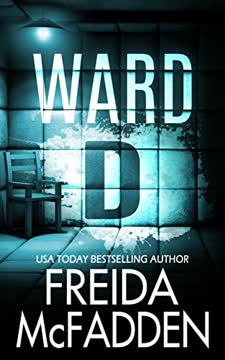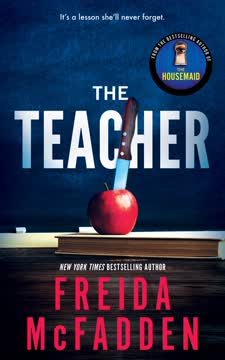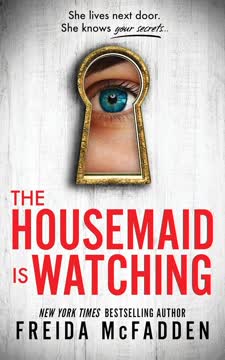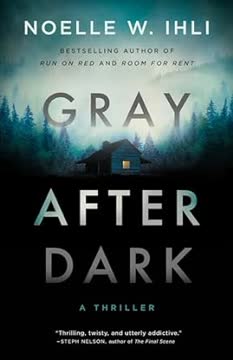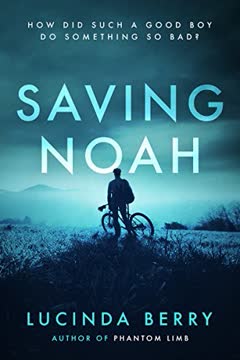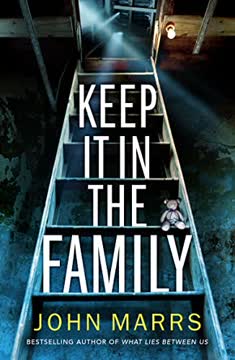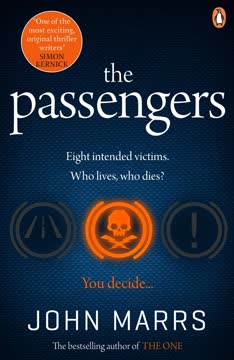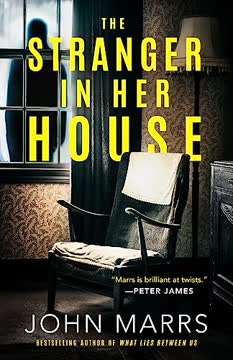Plot Summary
The Crow's Nest Prisoner
Maggie, an aging woman, spends her days locked in the attic of her own home, observing the world through shuttered windows. She is a ghost in her own life, isolated from the outside, her only company the books her daughter Nina brings her and the memories of a life that has gone terribly wrong. Maggie's existence is strictly controlled by Nina, who keeps her mother chained and locked away, feeding her, bathing her, and dictating every aspect of her life. The relationship between mother and daughter is fraught with unspoken resentments, old wounds, and a suffocating codependency. Maggie's internal monologue reveals a woman who has been both victim and perpetrator, haunted by regret and the knowledge that everything wrong in her life is mirrored in her daughter.
Dinner with Chains
Nina and Maggie's daily life is a ritual of control and passive aggression. Dinner is a battleground, with Maggie forced to eat what Nina cooks, often foods she dislikes, and always under the watchful eye of her captor-daughter. The house is a maze of locked doors, chains, and routines designed to keep Maggie compliant and contained. Their conversations are laced with barbs and reminders of past hurts, especially around the subject of children and lost opportunities. The power dynamic is constantly shifting, with Maggie occasionally testing boundaries, hiding objects, or attempting small acts of rebellion, only to be met with swift and sometimes violent retribution from Nina.
Fractured Reflections
Maggie's isolation leads her to obsess over the lives of her neighbors, the passage of time, and the many regrets that haunt her. She reflects on her lost friendships, her failed marriage, and the choices that led to her current imprisonment. The house itself becomes a character—claustrophobic, silent, and filled with the ghosts of the past. Maggie's only solace is in the books she reads, often thrillers and stories of captivity, which serve as both escape and cruel reminder of her own predicament. The psychological toll of her confinement is evident in her shifting moods, her longing for connection, and her growing sense of futility.
The Unraveling Past
The narrative shifts between present and past, revealing the events that led to Maggie's captivity. Through flashbacks, we see a family unraveling: a husband who leaves, a daughter who spirals into rebellion, and a mother who makes desperate choices to protect her child. The past is a minefield of trauma—abandonment, abuse, and betrayal. Maggie's attempts to shield Nina from harm only serve to deepen the wounds between them. The house, once a home, becomes a prison for both women, each trapped by the other's needs and failures.
Teenage Ruptures
As a teenager, Nina is wild, angry, and self-destructive. Her father's abandonment leaves her emotionally adrift, and she seeks solace in risky behavior—drinking, sex, and defiance. Maggie, overwhelmed and desperate, tries to maintain control but is increasingly powerless. The mother-daughter bond is tested to its limits as Nina's actions become more dangerous, culminating in a pregnancy that Maggie feels compelled to "solve" for her daughter, setting in motion a chain of secrets and lies that will haunt them both.
The First Betrayal
When Nina becomes pregnant as a young teen, Maggie intervenes without her daughter's knowledge, secretly inducing a miscarriage with stolen medication. She justifies her actions as necessary to protect Nina from a life she is unprepared for, but the betrayal is profound. Nina's trust is shattered, and Maggie's guilt festers. This act of "protection" becomes the template for their relationship—love expressed through control, care through coercion, and safety through secrecy.
A Daughter's Descent
Nina's teenage years are marked by a desperate search for love and belonging. She becomes involved with Jon Hunter, a charismatic but troubled local musician, and is drawn into his world of music, drugs, and adult relationships. The affair is both intoxicating and dangerous, as Jon is much older and the relationship is kept secret. Nina's sense of self is fragile, shaped by her need for validation and her mother's suffocating influence. The relationship with Jon becomes a defining trauma, leading to another pregnancy and a series of events that will have devastating consequences.
The Secret in the Basement
Nina's second pregnancy is hidden from Maggie until it is too late. When she goes into labor, Maggie delivers the baby herself, a girl Nina names Dylan. But the child is born with complications, and Maggie, convinced she is protecting her daughter, tells Nina the baby died. In reality, Maggie arranges for the child to be adopted by another family, erasing all traces of the birth and leaving Nina to grieve a loss she does not fully understand. This secret becomes the central lie that binds and destroys both women.
The Lost Child
Years later, the child—Dylan, now a young man named Bobby—reaches out to Nina, believing her to be his sister. Through a series of revelations, Nina discovers the truth: Dylan is her son, not her brother, and Maggie orchestrated his disappearance. The reunion is fraught with confusion, anger, and longing. Nina is forced to confront the reality of her mother's actions and the depth of her own loss. The fragile hope of reconciliation is quickly overshadowed by the weight of the past and the impossibility of undoing what has been done.
The Hunter's Shadow
The legacy of Jon Hunter looms large. He is eventually convicted of murder, a crime that may or may not be his, and dies in prison. The narrative reveals that Maggie, in her quest to protect Nina, may have played a role in framing Jon for a crime he did not commit. The cycle of violence and retribution continues, with Nina herself becoming both victim and perpetrator. The lines between love and hate, protection and punishment, blur until they are indistinguishable.
The Memory Box
A memory box, filled with relics of the past, becomes a symbol of the unresolved pain between Maggie and Nina. Each item—a photograph, a letter, a toy—carries the weight of what was lost and what was stolen. The box is both a comfort and a curse, a reminder of innocence and a record of betrayal. As the women sift through its contents, they are forced to confront the truth of their relationship and the impossibility of forgiveness.
The Second Child
Nina's inability to have more children, a result of the drugs Maggie gave her, becomes another source of grief and resentment. She attempts to adopt, seeking to fill the void left by Dylan, but is thwarted by Maggie's interference. The hunger for connection, for a family, drives Nina to increasingly desperate acts. The house becomes a mausoleum of lost possibilities, each room echoing with the ghosts of children who never were.
The Chain of Guilt
The relationship between Maggie and Nina deteriorates into open hostility and violence. Escape attempts, physical altercations, and psychological warfare become the norm. Both women are prisoners—Maggie literally, Nina emotionally. The arrival of Dylan, now an adult, offers a brief hope of redemption, but the cycle of trauma proves too strong. In a final confrontation, violence erupts, and Dylan is killed, the ultimate casualty of generational pain.
The Son Returns
Dylan's return to the house is a catalyst for the final unraveling. He discovers the truth of his origins, the depth of his mother's suffering, and the extent of Maggie's manipulations. The attempt to rescue Maggie from her captivity ends in disaster, as Nina, in a psychotic break, kills her own son. The tragedy is complete—three generations destroyed by secrets, lies, and the inability to break free from the past.
The Final Escape
With Dylan dead and her own health failing, Maggie sees only one way out. She sets fire to the house, determined to end the cycle of suffering once and for all. The fire consumes the home, the prison, and the evidence of all that has transpired. Nina survives, but is left alone, broken, and haunted by the ghosts of her family. The authorities arrive too late, finding only ruins and the bodies of Maggie and Dylan, chained and lost.
The Fire and the End
In the aftermath, Nina is left to face the consequences of her actions and the legacy of her family's pain. The fire is both literal and symbolic—a purging of the past, but also a final act of destruction. Maggie's last act is one of agency, choosing death over continued captivity, and in doing so, she frees herself and, in a twisted way, her daughter. The story ends with the recognition that true freedom can only come from confronting the truth, no matter how unbearable, and that the chains we forge for ourselves and others are the hardest to break.
Characters
Maggie Simmonds
Maggie is both victim and architect of her own suffering. Once a devoted mother and wife, her life is shattered by her husband's abandonment and her daughter's rebellion. Her attempts to protect Nina from harm lead her to commit acts of profound betrayal—inducing a miscarriage, giving away her grandchild, and ultimately imprisoning her daughter in a cycle of control and punishment. Maggie's psychological complexity is rooted in her inability to let go, her need to be needed, and her terror of abandonment. Over time, her love curdles into obsession, and her efforts to save Nina become the very thing that destroys them both. Her final act—setting fire to the house—is both a desperate bid for freedom and an acknowledgment of her own culpability.
Nina Simmonds
Nina is a woman defined by loss, longing, and rage. Abandoned by her father and betrayed by her mother, she seeks love and validation in all the wrong places. Her relationship with Jon Hunter is both a rebellion and a cry for help, leading to pregnancies, heartbreak, and the loss of her child. As an adult, Nina becomes her mother's jailer, repeating the cycle of control and punishment that defined her own upbringing. Her psychological unraveling is marked by dissociation, violence, and an inability to distinguish love from possession. The return of her son, Dylan, offers a fleeting hope of redemption, but her unresolved trauma leads to tragedy. Nina is both a victim and a perpetrator, her life a testament to the destructive power of secrets and unhealed wounds.
Jon Hunter
Jon is the enigmatic singer who becomes the object of Nina's obsession and the catalyst for much of the family's suffering. Charismatic, talented, and deeply flawed, he is both a victim of circumstance and a perpetrator of harm. His relationship with Nina is exploitative, yet he is also a casualty of Maggie's need to protect her daughter at any cost. Jon's eventual conviction for murder—possibly orchestrated by Maggie—serves as a grim reminder of the collateral damage wrought by generational trauma.
Dylan/Bobby
Dylan, stolen from his mother and raised by another family, is the embodiment of lost potential and the possibility of healing. His return to Nina and Maggie's lives is both a miracle and a curse, forcing all involved to confront the truth of their actions. Dylan's search for identity and belonging is met with love, confusion, and ultimately violence. His death at the hands of his mother is the story's most devastating moment, the final proof that some wounds cannot be healed.
Alistair Simmonds
Alistair's abandonment is the inciting trauma for both Maggie and Nina, but his true legacy is far darker. Hints and revelations suggest he may have abused Nina, a secret that Maggie suspects but cannot face. His murder—at Nina's hands, covered up by Maggie—sets the stage for the family's descent into madness and retribution.
Elsie
Elsie is Maggie's neighbor and occasional friend, a figure of stability and normalcy in a world gone mad. She assists Maggie in giving away Dylan, acting out of compassion but also a desire to help her friend escape an impossible situation. Elsie's presence is a reminder of the world outside, the life that might have been, and the cost of silence.
Jane
Jane, who raises Dylan as her own, is both a savior and a source of resentment for Nina. Her love for Dylan is genuine, but her presence is a constant reminder of what Nina has lost. The rivalry between the two women is rooted in their shared love for the same child and their inability to reconcile their roles in his life.
Sally Ann Mitchell
Sally Ann is Jon Hunter's pregnant girlfriend, a young woman caught in the crossfire of Maggie and Nina's war. Her brutal murder—possibly at Nina's hands, certainly covered up by Maggie—serves as a grim echo of the violence and secrecy that define the Simmonds family.
Dylan's Adoptive Family
Dylan's adoptive family represents the life he might have had—a life of stability, love, and opportunity. Their grief at his disappearance is genuine, and their inability to save him is a final, bitter irony.
Supporting Neighbors and Friends
The various neighbors, colleagues, and friends who populate the story serve as a backdrop to the central drama, their ordinary lives a stark contrast to the chaos within the Simmonds house. They are witnesses, sometimes complicit, sometimes oblivious, always powerless to intervene.
Plot Devices
Dual Narrative and Shifting Perspectives
The story is told through alternating chapters from Maggie and Nina's perspectives, with occasional interludes from the past and other characters. This structure allows the reader to see the same events through different, often contradictory, lenses. The use of unreliable narrators heightens the sense of uncertainty and dread, as each woman's version of the truth is shaped by trauma, denial, and self-justification.
Nonlinear Timeline and Flashbacks
The narrative moves fluidly between present-day captivity and key moments in the past—childhood, adolescence, pivotal traumas. This nonlinear approach mirrors the characters' fractured psyches and allows the gradual revelation of secrets, lies, and motivations. The past is never truly past; it is always intruding on the present, shaping actions and justifying sins.
Symbolism of the House and Chains
The house is both setting and symbol—a place of safety turned prison, filled with locked doors, hidden rooms, and secret compartments. Chains, padlocks, and physical restraints are literal manifestations of the psychological bonds that tie Maggie and Nina together. The memory box, the attic, the basement, and the garden grave all serve as metaphors for buried secrets and unresolved pain.
Foreshadowing and Repetition
The story is laced with foreshadowing—references to fire, escape, and death recur throughout, building a sense of inevitability. The repetition of routines, arguments, and failed escape attempts underscores the cyclical nature of trauma and the difficulty of breaking free from destructive patterns.
Psychological Realism and Dissociation
The narrative delves deeply into the psychological states of its characters, exploring dissociation, psychosis, and the ways in which trauma distorts memory and perception. The use of unreliable narration, hallucinations, and memory gaps reflects the characters' fractured realities and the impossibility of objective truth.
The Final Conflagration
The story culminates in a literal and symbolic fire, set by Maggie as an act of agency and escape. The fire consumes the house, the evidence, and the last vestiges of hope, leaving only ashes and the possibility of a new beginning. It is both an act of revenge and a final, desperate bid for freedom.
Analysis
What Lies Between Us is a harrowing exploration of the ways in which love, when twisted by fear, guilt, and trauma, can become indistinguishable from cruelty. The novel interrogates the boundaries between protection and possession, care and control, victim and perpetrator. Through its dual narrative and nonlinear structure, the story reveals how secrets, lies, and unhealed wounds are passed from one generation to the next, each act of "protection" sowing the seeds of future destruction. The house, with its locked doors and hidden graves, is a powerful metaphor for the psychological prisons we build for ourselves and those we love. The final act of fire is both a cleansing and a destruction, a recognition that some chains can only be broken by burning everything to the ground. Marrs's novel is a cautionary tale about the dangers of unresolved trauma, the limits of forgiveness, and the tragic consequences of love that cannot let go.
Last updated:
FAQ
Synopsis & Basic Details
What is What Lies Between Us about?
- A Mother's Captivity: The novel centers on Maggie, an elderly woman held captive in the attic of her own home by her daughter, Nina. Maggie observes the outside world through shuttered windows, a prisoner in her own life, haunted by past choices and the suffocating control of her daughter.
- Toxic Mother-Daughter Dynamic: The story explores the deeply dysfunctional and co-dependent relationship between Maggie and Nina, characterized by a ritualistic routine of control, passive aggression, and unspoken resentments that hint at a dark, shared history.
- Unraveling a Twisted Past: Through alternating perspectives and a non-linear timeline, the narrative gradually reveals the traumatic events and profound betrayals that led to Maggie's imprisonment, hinting at a cycle of love, control, and devastating secrets.
Why should I read What Lies Between Us?
- Masterful Psychological Suspense: John Marrs crafts a chilling domestic thriller that delves deep into the human psyche, offering a relentless build-up of tension and a constant questioning of reality, making it a compelling read for fans of psychological thrillers.
- Unreliable Narrators Explored: The dual perspectives of Maggie and Nina, both deeply flawed and unreliable, create a complex narrative puzzle, challenging readers to discern the truth amidst layers of manipulation, denial, and fractured memories.
- Shocking and Unpredictable Twists: The book is renowned for its unexpected plot twists that redefine character motivations and past events, ensuring a gripping experience that keeps readers guessing until the very last page.
What is the background of What Lies Between Us?
- Domestic Thriller Genre: The novel firmly sits within the domestic thriller genre, focusing on the dark underbelly of family relationships and the horrors that can unfold within the confines of a seemingly ordinary home, a signature style of John Marrs.
- Northamptonshire Setting: The story is primarily set in a quiet cul-de-sac in Northamptonshire, England, a seemingly mundane suburban backdrop that starkly contrasts with the psychological torment and hidden violence occurring within the main house.
- Exploration of Trauma's Legacy: The narrative implicitly draws on themes of generational trauma, exploring how unresolved past hurts, particularly abandonment and abuse, can manifest in destructive patterns of behavior across decades.
What are the most memorable quotes in What Lies Between Us?
- "A lie can travel halfway around the world while the truth is putting on its shoes.": This epigraph, attributed to Charles Spurgeon, perfectly encapsulates the novel's central theme of deception and the slow, painful emergence of buried truths, setting the stage for the intricate web of lies that defines the characters' lives.
- "Everything that is wrong with me is wrong with you too. We are one and the same. When I die, your flame will also extinguish.": Maggie's chilling internal monologue in the prologue highlights the profound, almost symbiotic, co-dependency and mutual destruction that defines her relationship with Nina, foreshadowing their intertwined fates.
- "I am a very, very lucky woman.": Nina's final thought, uttered amidst the ruins of her life and the bodies of her family, is a deeply ironic and disturbing statement that underscores her complete psychological break from reality, revealing the extent of her delusion and the tragic outcome of her actions.
What writing style, narrative choices, and literary techniques does John Marrs use?
- Alternating First-Person Perspective: Marrs employs a dual first-person narrative, switching between Maggie and Nina's viewpoints, which creates immediate intimacy with their thoughts and feelings while simultaneously highlighting their subjective and often contradictory interpretations of events.
- Non-Linear Chronology: The story frequently jumps between the present-day captivity and various points in the past (e.g., "Twenty-Five Years Earlier"), a non-linear structure that gradually reveals the complex origins of the characters' trauma and the secrets that bind them, building suspense and recontextualizing earlier scenes.
- Psychological Realism and Dissociation: Marrs delves deeply into the characters' fractured psyches, using internal monologues, memory gaps, and self-deception to create unreliable narrators. This technique forces the reader to constantly question what is real and who is truly sane, blurring the lines between victim and perpetrator.
Hidden Details & Subtle Connections
What are some minor details that add significant meaning?
- Elsie's Unwavering Suspicion: Elsie, the neighbor, consistently expresses doubt about Maggie's "dementia" and "move to Devon," telling Nina, "She was always sharp as a pin" and "I still don't understand how quickly it came on." This subtle, persistent skepticism from an outside observer hints at the truth of Maggie's captivity and Nina's deception, validating the reader's own unease.
- The Significance of ABBA's Music: Nina frequently plays ABBA's greatest hits, initially to "taunt" Maggie because it reminded her of Dad, but later it becomes a shared, albeit strained, ritual. The specific songs like "SOS" and "Does Your Mother Know" subtly mirror their dysfunctional relationship and the hidden truths, adding a layer of ironic commentary to their interactions.
- Maggie's Observation of Louise's Pregnancy: Maggie's detailed observation of Louise Thorpe's pregnancies, noting the previous loss and the current one, highlights Maggie's deep-seated maternal longing and her vicarious living. It also subtly foreshadows Nina's own hidden pregnancies and the tragic losses that define her character, creating a parallel between the two women's experiences of motherhood.
What are some subtle foreshadowing and callbacks?
- The Prologue's Ominous Tone: The opening lines, "I have stopped loving you. I have stopped caring about you. I have stopped worrying about you. I have simply . . . stopped," set an immediate tone of profound emotional detachment and foreshadow the ultimate severing of the relationship, culminating in Maggie's final, destructive act.
- Nina's "Red and Black" Vision: Nina's recurring experience of seeing the world in "red and black" during moments of extreme rage or dissociation subtly foreshadows her violent outbursts and her inability to control her darker impulses, linking her psychological state to her actions. This is seen when she attacks Maggie in the bathroom and later when she confronts Jane.
- The Memory Box's Contents: The memory box, initially dismissed by Maggie as a tool for Nina to "pile guilt," contains items like Nina's school reports and a wooden figure of Alistair. This seemingly innocuous collection subtly foreshadows the deeper, more traumatic memories Nina is trying to piece together about her father and her own past, which Maggie has suppressed.
What are some unexpected character connections?
- Elsie's Role in Dylan's Adoption: Elsie, the seemingly nosy neighbor, is revealed to be Maggie's confidante and an active participant in Dylan's adoption. She connects Maggie with Jane, the adoptive mother, stating, "I know a family who could help," revealing a surprising depth to her character beyond mere observation.
- The Delivery Man's Phone Number: The Argos delivery man, who gives Nina his number, is a seemingly throwaway detail that highlights Nina's isolation and longing for connection. It underscores her desperate need for external validation and a "normal" relationship, contrasting sharply with her hidden life.
- The Detective's Eye Color: In the epilogue, DI Lee Dalgleish is described as having one hazel and one pure grey eye, the latter being "the same shade as Dylan's and Jon's eyes." This subtle detail creates an unexpected, almost symbolic, connection between the investigating officer and the victims, hinting at a deeper, perhaps karmic, link to the family's tragic history.
Who are the most significant supporting characters?
- Elsie, the Unwitting Accomplice: Elsie is crucial not just as a neighbor, but as Maggie's only confidante and an active participant in Dylan's adoption. Her seemingly benign presence and willingness to help Maggie conceal the truth make her a significant, albeit morally ambiguous, supporting character.
- Jane, the Unseen Rival: Dylan's adoptive mother, Jane, serves as Nina's primary rival for Dylan's affection and identity. Her genuine love and stable home life for Dylan highlight Nina's own deficiencies and the life she was denied, fueling Nina's resentment and ultimately leading to the tragic confrontation.
- Bobby/Dylan, the Catalyst for Truth: Dylan, initially appearing as a half-brother, is the central catalyst for the unraveling of Maggie's elaborate lies. His search for his biological family forces Nina to confront her past and Maggie to face the consequences of her actions, driving the plot towards its devastating climax.
Psychological, Emotional, & Relational Analysis
What are some unspoken motivations of the characters?
- Maggie's Fear of Abandonment: Beyond protecting Nina, Maggie's actions are deeply rooted in her own fear of abandonment, stemming from her emotionally distant mother and Alistair's perceived departure. Her desire to keep Nina close, even through captivity, is an unspoken attempt to prevent her own loneliness, as she admits, "I'm not lonely! Only because you have me here."
- Nina's Quest for a "Normal" Family: Nina's relentless pursuit of a child, first through adoption and then through her desperate attempts to bond with Dylan, is driven by an unspoken longing for the "normal" family life she was denied. Her actions, though extreme, are a twisted manifestation of her desire to fill the void left by her father's absence and her lost children.
- Alistair's Hidden Depravity: While his abuse of Nina is never explicitly detailed, Maggie's internal monologues ("What has he done to you?", "his was the face of a man who had been caught red-handed doing the worst possible thing he could do to a child") strongly imply a history of sexual abuse. This unspoken motivation for Nina's initial violence is the dark secret Maggie protects at all costs.
What psychological complexities do the characters exhibit?
- Maggie's Self-Justification and Denial: Maggie exhibits profound psychological complexity through her constant self-justification for her horrific actions (inducing miscarriage, giving away Dylan, framing Jon). She genuinely believes she is "protecting" Nina, even as her methods become increasingly cruel, showcasing a deep-seated denial of her own culpability and a warped sense of maternal love.
- Nina's Dissociative Identity and Rage: Nina's "red and black" episodes and her inability to recall violent acts (like attacking Maggie or Dylan) point to dissociative states, a psychological defense mechanism against extreme trauma. This allows her to commit atrocities while maintaining a fragmented sense of innocence, making her a truly complex and terrifying character.
- The Cycle of Abuse and Co-dependency: The novel intricately portrays how the trauma inflicted by Alistair on Nina, and subsequently by Maggie on Nina, creates a vicious cycle of abuse and co-dependency. Both women are simultaneously victims and perpetrators, trapped in a symbiotic relationship where their identities and suffering are inextricably linked, as Maggie states, "We are one and the same."
What are the major emotional turning points?
- Nina's Discovery of Moxydogrel: The moment Nina finds the Moxydogrel boxes and researches the drug's effects (memory loss, infertility, early menopause) is a pivotal emotional turning point. This revelation shatters her perception of Maggie as a protective mother and fuels her desire for revenge, leading directly to Maggie's captivity.
- Maggie's Cancer Diagnosis: Maggie's discovery of a breast lump and subsequent secondary lumps marks a significant emotional shift. It forces her to confront her own mortality and the futility of her captivity, leading to a desperate desire for freedom and ultimately her decision to set the fire, as she realizes, "I want this to be cancer and I want it to kill me."
- Dylan's Death: The accidental death of Dylan at Nina's hands is the ultimate emotional climax, representing the tragic culmination of all the family's secrets and violence. It shatters any remaining hope for reconciliation or a "normal" life, leaving both Maggie and Nina utterly broken and leading to Maggie's final, desperate act.
How do relationship dynamics evolve?
- From Parental Control to Captivity: The relationship shifts from Maggie's attempts to control Nina's rebellious adolescence to Nina's complete physical captivity of Maggie. This evolution demonstrates a reversal of power dynamics, where the once-controlled daughter becomes the controller, mirroring the abuse she experienced.
- Co-dependency to Mutual Destruction: What begins as a strained co-dependency, where both women rely on each other for their twisted sense of purpose, gradually devolves into outright mutual destruction. Their interactions become increasingly violent and psychologically damaging, culminating in the deaths of Alistair and Dylan, and ultimately Maggie's suicide.
- The Illusion of Reconciliation: Brief moments of apparent connection, such as shared laughter over old memories or Nina's attempts to care for Maggie's cancer, offer fleeting illusions of reconciliation. However, these are consistently shattered by underlying resentments and the inability to escape their destructive patterns, highlighting the impossibility of true healing without confronting the full truth.
Interpretation & Debate
Which parts of the story remain ambiguous or open-ended?
- The Full Extent of Alistair's Abuse: While strongly implied through Maggie's internal monologues and Nina's violent reaction, the exact nature and duration of Alistair's abuse of Nina are never explicitly detailed. This ambiguity leaves readers to grapple with the horrific implications and the depth of the trauma that triggered the family's downfall.
- Nina's True Mental State: The narrative leaves open to interpretation whether Nina's violent outbursts and memory gaps are purely a result of Maggie's drugging and manipulation, or if she possesses an inherent psychological predisposition to violence and dissociation. Maggie's final thoughts question if she is "the unreliable narrator," adding to this ambiguity.
- The Detective's Final Gaze: The ending with DI Lee Dalgleish's "two different colors" eyes and his piercing gaze into Nina's "black" world leaves her fate ambiguous. It suggests she is finally caught, but also hints at a deeper, perhaps supernatural, understanding of the darkness within her, leaving her ultimate psychological state and future open to interpretation.
What are some debatable, controversial scenes or moments in What Lies Between Us?
- Maggie's Decision to Induce Miscarriage: Maggie's secret act of giving Nina Clozterpan to induce a miscarriage is highly controversial. While she justifies it as protecting a 14-year-old from an unwanted pregnancy and a life with Jon Hunter, it is a profound violation of Nina's bodily autonomy and a betrayal that sets the stage for decades of resentment and revenge.
- Maggie Framing Jon Hunter: Maggie's deliberate manipulation of the crime scene to frame Jon Hunter for Sally Ann Mitchell's murder is a morally debatable act. Her motivation is to protect Nina from the consequences of her own violence, but it condemns an innocent (or at least, not solely guilty) man to prison for life, raising questions about the lengths a mother will go to for her child.
- Nina's Captivity of Maggie and Dylan: Nina's decision to imprison both Maggie and later Dylan in the house, chaining them and controlling their lives, is a central controversial element. While presented as a form of "repayment" for Maggie's past actions, it mirrors the very abuse she suffered, perpetuating a cycle of cruelty and raising questions about the nature of justice and revenge.
What Lies Between Us Ending Explained: How It Ends & What It Means
- Maggie's Final Act of Agency: The ending sees Maggie, suffering from cancer and despair, deliberately setting fire to the house. This act is her ultimate escape from captivity and a final assertion of control over her own destiny, choosing death on her own terms rather than succumbing to Nina's prolonged torment. It is a tragic liberation, as she states, "Only then will I be free of her."
- The Cycle of Trauma Consumes All: The fire tragically claims Dylan's life, who was unknowingly imprisoned in the basement. His death, at Nina's hands (indirectly, through her neglect and Maggie's final act), signifies the complete consumption of the family by their unresolved trauma and secrets. The "innocent" party, Dylan, becomes the ultimate casualty, highlighting the devastating ripple effect of generational pain.
- Nina's Ultimate Isolation and Psychological Collapse: Nina survives the fire but is left utterly alone, her family home destroyed, and her mother and son dead. The final scene with DI Dalgleish suggests she is finally exposed and likely faces legal consequences. Her descent into "black" symbolizes her complete psychological collapse and the final, inescapable prison of her own making, a chilling conclusion to the themes of control, revenge, and the impossibility of true escape in What Lies Between Us.
Review Summary
What Lies Between Us is a dark psychological thriller about a mother and daughter with a twisted relationship. Many readers found it gripping and shocking, praising the complex characters and unexpected twists. The story alternates between perspectives, slowly revealing secrets and motivations. While some predicted certain plot points, most were captivated by the disturbing tale. A few felt it was too unbelievable or lacked closure, but overall, it was well-received as an addictive, mind-bending read that showcases Marrs' storytelling skills.
Similar Books
Download PDF
Download EPUB
.epub digital book format is ideal for reading ebooks on phones, tablets, and e-readers.

